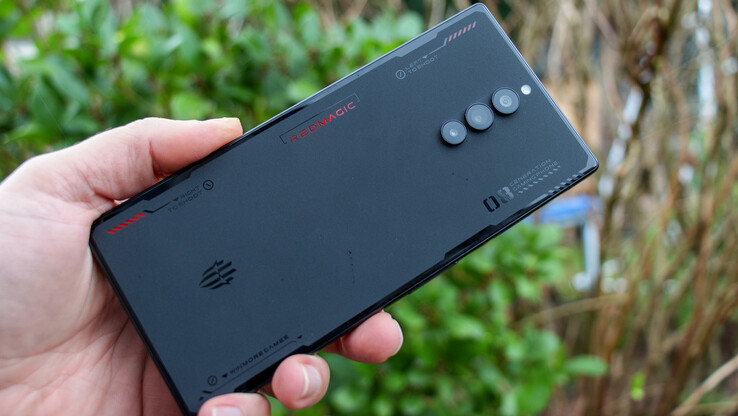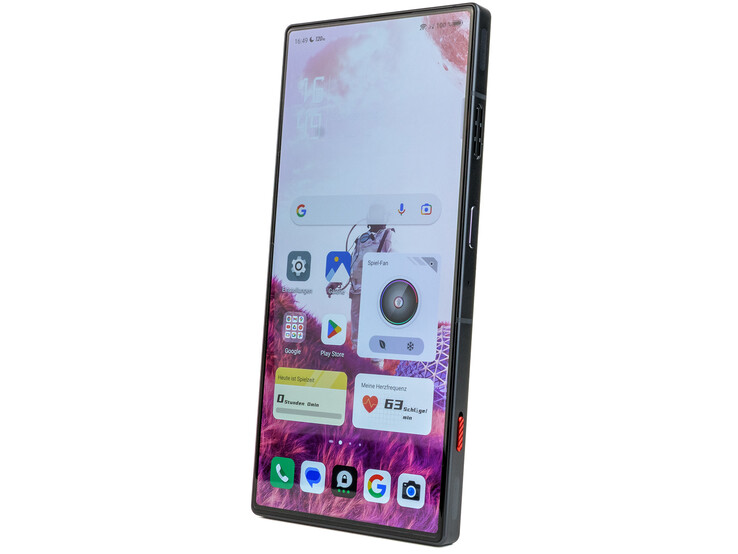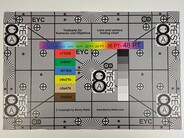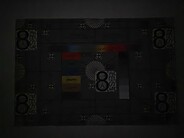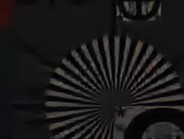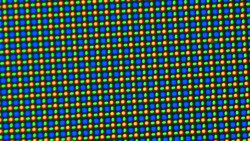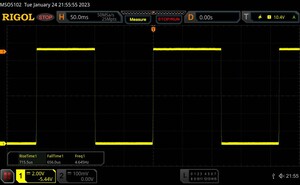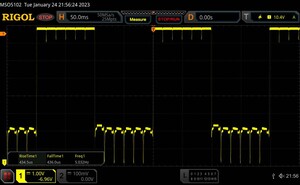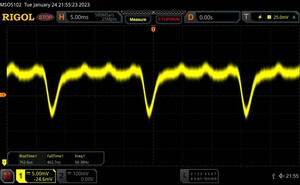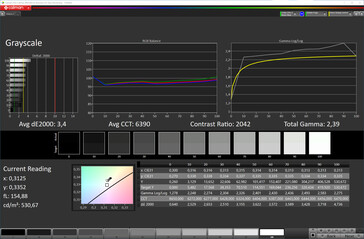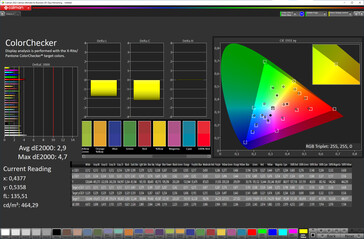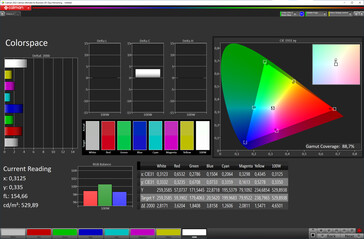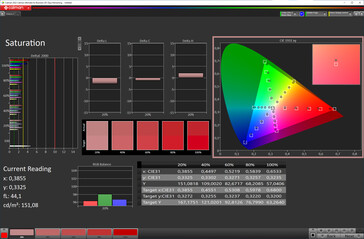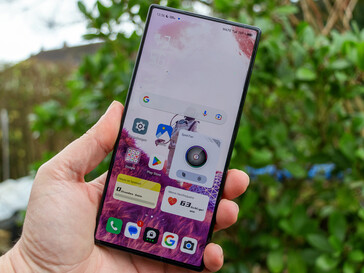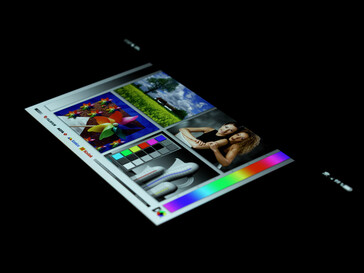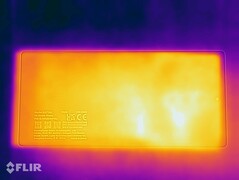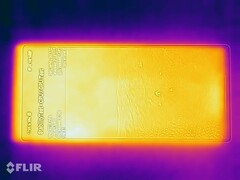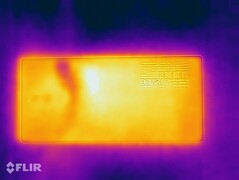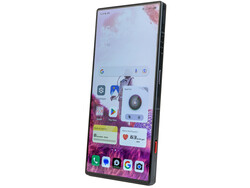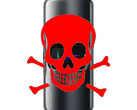Nubia RedMagic 8 Pro review - Gaming smartphone with 100% performance
Possible competitors in comparison
Rating | Date | Model | Weight | Drive | Size | Resolution | Best Price |
|---|---|---|---|---|---|---|---|
| 85.9 % | 02/2023 | Nubia RedMagic 8 Pro SD 8 Gen 2, Adreno 740 | 228 g | 256 GB UFS 4.0 Flash | 6.80" | 2480x1116 | |
| 84.9 % | 09/2022 | Nubia RedMagic 7S Pro SD 8+ Gen 1, Adreno 730 | 235 g | 256 GB UFS 3.1 Flash | 6.80" | 2400x1080 | |
| 89.5 % | 01/2023 | Asus ROG Phone 6 Pro SD 8+ Gen 1, Adreno 730 | 239 g | 512 GB UFS 3.1 Flash | 6.78" | 2448x1080 | |
| 85.7 % | 06/2022 | Xiaomi Black Shark 5 Pro SD 8 Gen 1, Adreno 730 | 220 g | 256 GB UFS 3.1 Flash | 6.67" | 2400x1080 |
Case and features - RedMagic 8 Pro with additional touch elements
The Nubia RedMagic 8 Pro design already clearly identifies it as a gaming smartphone. It is available in Matte and Void color versions. The latter has a partially transparent back with an illuminated RGB LED fan and more storage (16/512 GB), whereas our matte review sample has a black back. There, the RedMagic logo and other elements can be illuminated with customizable LED illumination.
The build quality is good and convinces with tight and even gaps. The display-to-surface ratio of 88 percent is also very good, mainly due to the camera underneath the display (UDC). The two touch surfaces on the right long side can be configured as additional input elements for games and have not changed in terms of the sampling rate (520 Hz) compared to those of the predecessor.
Communication, software and operation
The mobile connectivity of the RedMagic 8 Pro is inconspicuous in the test and can fall back on a broad frequency band support. The voice quality is good when held to the ear, but not too much should be expected from the ambient noise suppression. With Wi-Fi 7, the smartphone supports the most modern WLAN standard and also shows a strong improvement in connection speed tests. The transmission rates are very good in the 6 GHz network, but only VHT80 is supported in the 2.4 and 5.0 GHz networks.
The RedMagic smartphone ships with Google Android 13 and the RedMagic OS 6.0 interface. The security patches are on November 1, 2022 at the time of the test and thus no longer up-to-date. There are currently no concrete statements about the duration or the interval of the update supply from the manufcturer. However, experience shows that at least one major upgrade can be expected.
Biometric security is provided by an optical fingerprint sensor integrated into the display, which does its job satisfactorily and can even measure the pulse. Alternatively or additionally, a less secure facial recognition via the front camera can be used. Besides the two additional capacitive shoulder buttons, there is also a prominent red button in the bezel that switches the smartphone to a special gaming interface. Settings for the individual games can be made there and the RGB lighting can be configured.
| Networking | |
| Nubia RedMagic 8 Pro | |
| iperf3 transmit AXE11000 |
|
| iperf3 receive AXE11000 |
|
| iperf3 transmit AXE11000 6GHz |
|
| iperf3 receive AXE11000 6GHz |
|
| Nubia RedMagic 7S Pro | |
| iperf3 transmit AXE11000 |
|
| iperf3 receive AXE11000 |
|
| Asus ROG Phone 6 Pro | |
| iperf3 transmit AXE11000 |
|
| iperf3 receive AXE11000 |
|
| iperf3 transmit AXE11000 6GHz |
|
| iperf3 receive AXE11000 6GHz |
|
| Xiaomi Black Shark 5 Pro | |
| iperf3 transmit AXE11000 6GHz |
|
| iperf3 receive AXE11000 6GHz |
|
Cameras - Well camouflaged UDC in the RedMagic 8 Pro
The front-facing camera of the Nubia RedMagic 8 Pro is not located in the display, but underneath it. It is once again a so-called under-display camera (UDC), which is hardly visible. The photos do not necessarily shine with rich details or color brilliance, but the UDC is definitely one of the better ones of its kind. Videos are recorded in Full HD (30 FPS) at best.
The triple camera on the back can rely on an additional ultra wide-angle and a macro lens. However, their quality is rather mediocre. The 50 MPix main camera, on the other hand, takes good pictures in daylight with comparatively natural color reproduction. It can even record videos in 8k.
Image Comparison
Choose a scene and navigate within the first image. One click changes the position on touchscreens. One click on the zoomed-in image opens the original in a new window. The first image shows the scaled photograph of the test device.
Main cameraMain cameraUltra wide-angle5x ZoomLow-Light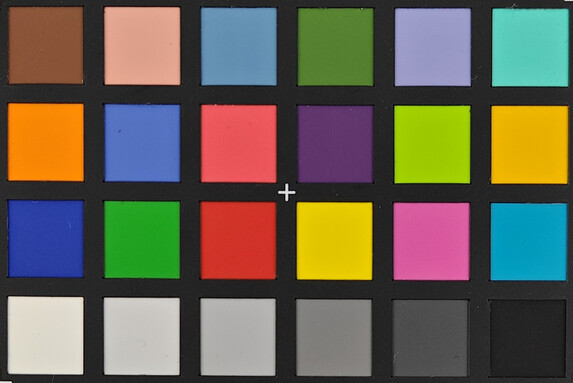
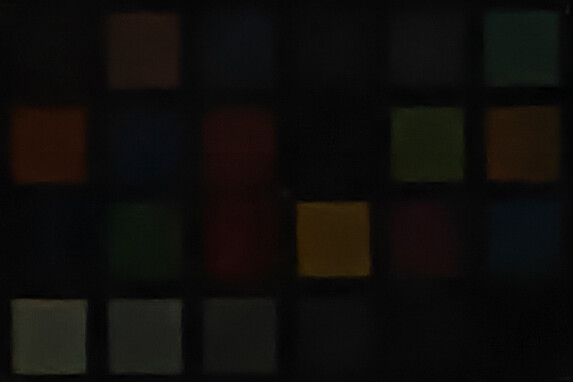
Display - Bright 120 Hz AMOLED in the RedMagic smartphone
The RedMagic 8 Pro once again has a 6.8-inch AMOLED display that has a refresh rate of up to 120 Hz. This can be set to either 60, 90, or 120 Hz, but the system does not automatically adjust it.
The brightness of the gaming smartphone increases considerably and climbs to an average value of 817 cd/m² (7S Pro: 627 cd/m²), and even 995 cd/m² (APL18) are possible at the peak. The HDR standards HLG and HDR10 are supported.
The OLED panel uses pulse-width modulation, but with a very constant and flat curve. We can only measure a frequency of 60 Hz, which indicates permanent DC dimming.
| |||||||||||||||||||||||||
Brightness Distribution: 91 %
Center on Battery: 811 cd/m²
Contrast: ∞:1 (Black: 0 cd/m²)
ΔE Color 2.9 | 0.5-29.43 Ø5
ΔE Greyscale 3.4 | 0.57-98 Ø5.3
98.7% sRGB (Calman 2D)
Gamma: 2.39
| Nubia RedMagic 8 Pro AMOLED, 2480x1116, 6.80 | Nubia RedMagic 7S Pro AMOLED, 2400x1080, 6.80 | Asus ROG Phone 6 Pro AMOLED, 2448x1080, 6.78 | Xiaomi Black Shark 5 Pro AMOLED, 2400x1080, 6.67 | |
|---|---|---|---|---|
| Response Times | 398% | 342% | -261% | |
| Response Time Grey 50% / Grey 80% * | 0.87 ? | 1.27 ? -46% | 1.042 ? -20% | 6 ? -590% |
| Response Time Black / White * | 1.37 ? | 1.3 ? 5% | 0.998 ? 27% | 8 ? -484% |
| PWM Frequency | 60 | 801 1235% | 672.1 1020% | 235 292% |
| Screen | -14% | 13% | -24% | |
| Brightness middle | 811 | 618 -24% | 860 6% | 642 -21% |
| Brightness | 817 | 627 -23% | 868 6% | 637 -22% |
| Brightness Distribution | 91 | 91 0% | 97 7% | 96 5% |
| Black Level * | ||||
| Colorchecker dE 2000 * | 2.9 | 2.9 -0% | 2.4 17% | 3.19 -10% |
| Colorchecker dE 2000 max. * | 4.7 | 5.7 -21% | 3.9 17% | 7.12 -51% |
| Greyscale dE 2000 * | 3.4 | 4 -18% | 2.5 26% | 4.9 -44% |
| Gamma | 2.39 92% | 2.35 94% | 2.08 106% | 2.22 99% |
| CCT | 6390 102% | 6098 107% | 6640 98% | 7671 85% |
| Total Average (Program / Settings) | 192% /
123% | 178% /
123% | -143% /
-103% |
* ... smaller is better
Display Response Times
| ↔ Response Time Black to White | ||
|---|---|---|
| 1.37 ms ... rise ↗ and fall ↘ combined | ↗ 0.7155 ms rise | |
| ↘ 0.656 ms fall | ||
| The screen shows very fast response rates in our tests and should be very well suited for fast-paced gaming. In comparison, all tested devices range from 0.1 (minimum) to 240 (maximum) ms. » 4 % of all devices are better. This means that the measured response time is better than the average of all tested devices (21.5 ms). | ||
| ↔ Response Time 50% Grey to 80% Grey | ||
| 0.87 ms ... rise ↗ and fall ↘ combined | ↗ 0.4345 ms rise | |
| ↘ 0.436 ms fall | ||
| The screen shows very fast response rates in our tests and should be very well suited for fast-paced gaming. In comparison, all tested devices range from 0.2 (minimum) to 636 (maximum) ms. » 1 % of all devices are better. This means that the measured response time is better than the average of all tested devices (33.7 ms). | ||
Screen Flickering / PWM (Pulse-Width Modulation)
| Screen flickering / PWM detected | 60 Hz | ||
The display backlight flickers at 60 Hz (worst case, e.g., utilizing PWM) . The frequency of 60 Hz is very low, so the flickering may cause eyestrain and headaches after extended use. In comparison: 53 % of all tested devices do not use PWM to dim the display. If PWM was detected, an average of 17900 (minimum: 5 - maximum: 3846000) Hz was measured. | |||
Measurement series with fixed zoom level and different brightness settings
Performance, emissions, and battery life - Full throttle with the Snapdragon 8 Gen 2
The RedMagic 8 Pro is powered by the latest Snapdragon 8 Gen 2 and can use 12 or 16 GB of LPDDR5x working memory depending on the model. Thanks to the integrated fan, the SoC's performance remains permanently stable and the surface temperatures are not even lukewarm. In return, the small fan gets quite loud and climbs above 44 dB(A) under full load. Since it also whistles at a very high frequency, the noise is quite annoying in the long run.
The two speakers do a decent job. However, headphones are more suitable due to the fan, especially since the audio jack proves to be quite low-noise (SPL: 87.47 dBFS). Broad audio codec support (SBC, AAC, aptX, aptX HD, aptX Adaptive, aptX TWS+, and LDAC) is also offered for wireless headphones.
The 6,000 mAh strong battery lasts for an enormously long time even with 120 Hz enabled.
| GFXBench | |
| on screen Aztec Ruins Normal Tier Onscreen | |
| Xiaomi 13 | |
| Average Qualcomm Snapdragon 8 Gen 2 (45 - 143, n=19) | |
| Nubia RedMagic 7S Pro | |
| Asus ROG Phone 6 Pro | |
| Average of class Smartphone (3.6 - 123, n=226, last 2 years) | |
| Xiaomi Black Shark 5 Pro | |
| 1920x1080 Aztec Ruins Normal Tier Offscreen | |
| Average Qualcomm Snapdragon 8 Gen 2 (82 - 181, n=19) | |
| Xiaomi 13 | |
| Nubia RedMagic 7S Pro | |
| Asus ROG Phone 6 Pro | |
| Average of class Smartphone (2.3 - 229, n=226, last 2 years) | |
| Xiaomi Black Shark 5 Pro | |
| on screen Aztec Ruins High Tier Onscreen | |
| Xiaomi 13 | |
| Average Qualcomm Snapdragon 8 Gen 2 (43 - 97, n=19) | |
| Asus ROG Phone 6 Pro | |
| Xiaomi Black Shark 5 Pro | |
| Nubia RedMagic 7S Pro | |
| Average of class Smartphone (2.8 - 119, n=226, last 2 years) | |
| 2560x1440 Aztec Ruins High Tier Offscreen | |
| Average Qualcomm Snapdragon 8 Gen 2 (24 - 72, n=19) | |
| Xiaomi 13 | |
| Asus ROG Phone 6 Pro | |
| Nubia RedMagic 7S Pro | |
| Average of class Smartphone (0.85 - 94, n=226, last 2 years) | |
| Xiaomi Black Shark 5 Pro | |
| UL Procyon AI Inference for Android - Overall Score NNAPI | |
| Asus ROG Phone 6 Pro | |
| Average of class Smartphone (207 - 84787, n=150, last 2 years) | |
| Nubia RedMagic 8 Pro | |
| Xiaomi 13 | |
| Average Qualcomm Snapdragon 8 Gen 2 (11338 - 16880, n=16) | |
| Nubia RedMagic 8 Pro | Nubia RedMagic 7S Pro | Asus ROG Phone 6 Pro | Xiaomi Black Shark 5 Pro | Xiaomi 13 | Average 256 GB UFS 4.0 Flash | Average of class Smartphone | |
|---|---|---|---|---|---|---|---|
| AndroBench 3-5 | -42% | -33% | -31% | -2% | -10% | -51% | |
| Sequential Read 256KB | 3556.62 | 1822.05 -49% | 1949.16 -45% | 1945.4 -45% | 3454.01 -3% | 3558 ? 0% | 1508 ? -58% |
| Sequential Write 256KB | 2719.64 | 1258.69 -54% | 1454.5 -47% | 1485.2 -45% | 2722.77 0% | 2443 ? -10% | 1118 ? -59% |
| Random Read 4KB | 393.88 | 327.23 -17% | 297.48 -24% | 344.9 -12% | 393.81 0% | 414 ? 5% | 247 ? -37% |
| Random Write 4KB | 551.93 | 287.63 -48% | 459.66 -17% | 424.8 -23% | 536.76 -3% | 367 ? -34% | 272 ? -51% |
Temperature
(+) The maximum temperature on the upper side is 30.3 °C / 87 F, compared to the average of 35 °C / 95 F, ranging from 21.9 to 56 °C for the class Smartphone.
(+) The bottom heats up to a maximum of 30.1 °C / 86 F, compared to the average of 33.8 °C / 93 F
(+) In idle usage, the average temperature for the upper side is 26.3 °C / 79 F, compared to the device average of 32.7 °C / 91 F.
3DMark Wild Life Stress Test
Speaker
Nubia RedMagic 8 Pro audio analysis
(+) | speakers can play relatively loud (92.9 dB)
Bass 100 - 315 Hz
(-) | nearly no bass - on average 18.8% lower than median
(+) | bass is linear (2.5% delta to prev. frequency)
Mids 400 - 2000 Hz
(±) | higher mids - on average 6.4% higher than median
(+) | mids are linear (5.1% delta to prev. frequency)
Highs 2 - 16 kHz
(±) | higher highs - on average 7.7% higher than median
(+) | highs are linear (4.6% delta to prev. frequency)
Overall 100 - 16.000 Hz
(±) | linearity of overall sound is average (18.6% difference to median)
Compared to same class
» 15% of all tested devices in this class were better, 8% similar, 76% worse
» The best had a delta of 12%, average was 38%, worst was 134%
Compared to all devices tested
» 37% of all tested devices were better, 8% similar, 56% worse
» The best had a delta of 4%, average was 25%, worst was 134%
Asus ROG Phone 6 Pro audio analysis
(+) | speakers can play relatively loud (93.3 dB)
Bass 100 - 315 Hz
(-) | nearly no bass - on average 22.6% lower than median
(+) | bass is linear (3.9% delta to prev. frequency)
Mids 400 - 2000 Hz
(+) | balanced mids - only 4.7% away from median
(+) | mids are linear (3.9% delta to prev. frequency)
Highs 2 - 16 kHz
(+) | balanced highs - only 2.7% away from median
(+) | highs are linear (3.2% delta to prev. frequency)
Overall 100 - 16.000 Hz
(±) | linearity of overall sound is average (15.5% difference to median)
Compared to same class
» 2% of all tested devices in this class were better, 2% similar, 96% worse
» The best had a delta of 12%, average was 38%, worst was 134%
Compared to all devices tested
» 19% of all tested devices were better, 4% similar, 78% worse
» The best had a delta of 4%, average was 25%, worst was 134%
Battery life
| Battery Runtime - WiFi Websurfing | |
| Nubia RedMagic 8 Pro | |
| Asus ROG Phone 6 Pro | |
| Average of class Smartphone (424 - 2844, n=228, last 2 years) | |
| Xiaomi Black Shark 5 Pro | |
| Nubia RedMagic 7S Pro | |
Pros
Cons
Verdict - RedMagic 8 Pro turns out to be a fast-paced gamer
The Nubia RedMagic 8 Pro is a real gaming smartphone, which also underlines this in terms of design and integrated RGB lighting. The fan puts the icing on the cake and proves to be very effective in the test, but unfortunately also quite loud.
The additional sensor keys on the long side are also a real added value when gaming. A full-fledged audio jack is also a rarity. This is rounded off with fast and modern communication equipment.
The RedMagic 8 Pro offers a lot of gaming power at an attractive entry-level price.
In contrast to the higher-priced competition, you have to do without a few HDR standards, among other things, and the panel is also not quite as bright. An automatic adjustment of the refresh rate would certainly have been desirable. The cameras cannot convince in all areas either, but the UD camera offers the big advantage of not leaving a visible interruption in the display. The biggest compromise is the uncertain duration of the update supply. More than one major update will probably not be possible.
Our test model is already available directly from RedMagic starting at 649 Euros. Those who want to own the Void design version with more memory will have to shell out 799 Euros. Strong alternatives, but still with last year's SoCs, are the Asus ROG Phone 6 Pro, ROG Phone 6D, and the Black Shark 5 Pro.
Price and availability
The Nubia RedMagic 8 Pro can be purchased directly from the manufacturer's store at https://eu.redmagic.gg/de/products/redmagic-8-pro but is also available on Amazon.
Nubia RedMagic 8 Pro
-
02/17/2023 v7
Daniel Schmidt


 Deutsch
Deutsch English
English Español
Español Français
Français Italiano
Italiano Nederlands
Nederlands Polski
Polski Português
Português Русский
Русский Türkçe
Türkçe Svenska
Svenska Chinese
Chinese Magyar
Magyar